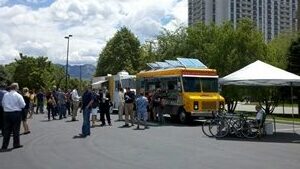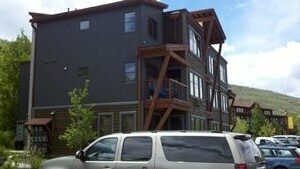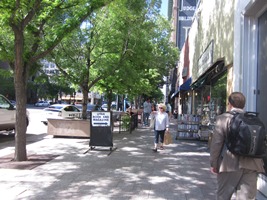A couple of weeks ago, I had the opportunity to attend the Congress for the New Urbanism 
There were so many different topics, impromptu conversations, random small group meetings, and a wide variety of tours, making it difficult to choose what to participate in, but here are a few highlights:
- As the co-founder of the Congress for the New Urbanism it wouldn’t be a CNU conference without Andres Duany. His passion for what he does was visible through his opening address and throughout the conference as he informally engaged in conversations with attendees. (My colleague Arnold Weinfeld and I were having breakfast with Craig Chester from Smart Growth America and Joh Geeting, writer/blogger and political consultant, when Duany joined us for breakfast. We were of course, very honored and enjoyed a lively conversation.) His common theme (or rant!) was the need to knock down the bureaucracy to allow to build live, work, play communities and deliver a world where the young can operate. He castigated the American environmentalists who operate without taking humans into consideration. He talked a lot about the beach mouse in Florida, and how you can’t build because of the beach mice. At first I thought that “beach mouse” was his metaphor for not being able to get anything done. But he was actually talking about real beach mice! He went on to say that Landscape urbanists don’t let us build cities. (He uses the test of not being able to build Charleston again.) Duany also spoke about the need to come up with simple and lean codes, what he calls a transect-based “Pink Code.” (I should also mention, he will be the keynote speaker at the League’s Annual Convention in Detroit in September!)
- Arnold and I toured Park City, home to the Sundance Festival and a year-round
tourist destination. Located 32 miles southeast of Utah, over 7,000 people call it home. The focus of the tour was affordable housing. It was nothing short of impressive to see Park City’s commitment to providing affordable housing in a city that attracts the rich and famous. With a progressive mayor (he had a brief encounter with the political hippie movement in the 60s in Ann Arbor!) who is passionate about his community and its residents, he showed us several outstanding examples of green and affordable housing and how the community has embraced sustainable construction. There is a serious commitment to making this community welcoming to different socio-economic groups.
- I set out on a tour of Daybreak, not really knowing in advance where that was and what it was all about. The purpose was to see an example of elder housing. I (along with some others) was a bit shocked to arrive at the last Trax (light rail) stop, 45 minutes from downtown Salt Lake City. (The light rail also gives access to the airport and the University of Utah.) With no protection from the sun and strong gusts of wind hurtling towards us (apparently it’s always windy there), we walked to a newly constructed master planned community of over 4,000 acres, using a Traditional Neighborhood Development model (TND) which has been in the making for the past 10 years. This means that all homes within the community are within a five-minute walk or bike ride of a park, lake, shopping area, etc. All the homes are Energy star certified. The community broke ground in 2004 and plans to continue building for the next 20 years with more than 20,000 residential units. The community is divided into four villages, one of them designed for over 55 years old, which was the primary focus of our visit. Some of the housing is clustered facing each other, which reminded me of a great example of Umatilla Hill pocket neighborhood in Port Townsend, WA that I visited last year. Daybreak now hosts 3 schools, churches, health services, movie theater and a community center. A few of us had a chance to talk to some young teenage boys who were skateboarding. They said that they loved living there because there was so much to do and they could walk and bike everywhere. Although I seriously question why a community like this is being built so far out, it was impressive.
Salt Lake City is the largest city in Utah, with a population of a little under 200,000 (and over a million regionally). The downtown has very wide streets; up to 9 lanes. Their width has not changed since they accommodated oxen and their carts in the 1800s. However, the city has turned them into pedestrian/bike friendly. On some of the main streets, light rail travels down the middle, calming the traffic on either side. The city has done an excellent job with wide sidewalks and trees and other large plantings, acting as a buffer between the pedestrian and the street. It is a very walkable city and feels very safe. Add in the light rail, and it is easy to get around without a car. Through another organized tour, I visited several neighborhoods which are located on the diagonal grid in Salt Lake City. It presented a new perspective on the city, with its small intimate tree-lined streets interspersed with small businesses.
- Living in a society where big is better, Susan Susanka, author of the Not so Big House (among others), begs to differ. She presented at a Plenary session on “Not so Big Meets the New Urbanism.” She says that everyone is searching for a sense of home; something that will make us feel better. The feeling of home has almost nothing to do with size. Community is a quality too. It’s all about relationships and our interconnectedness that matters.
- Tactical Urbanism is a term that is getting a lot of play these days and encompasses a lot of different placemaking concepts: pop-ups; Lighter, Quicker, Cheaper; short-term action; long term change; a deliberate approach to instigate change; the development of social change. There were many different sessions and discussion groups devoted to this topic. One that I participated in was an open-source group that discussed the role that local government plays in tactical urbanism action. This really goes to the heart of what the League has been saying for years – that local governments need to be the host of the party, not the life of the party. They need to remove barriers, help solve problems, and assist in expediting the process
- Although there were only a handful of Michiganians attending, I felt a lot of pride for the great placemaking happening around Michigan. Several people that I met were clearly aware of some of the outstanding projects going on here. This conference reinforced the importance of getting out of our own back yards. It allows us to foster new relationships with people who share our visions and passions. While sometimes reinforcing the old, it helps us gain new perspectives and ideas to bring back to the home front.

